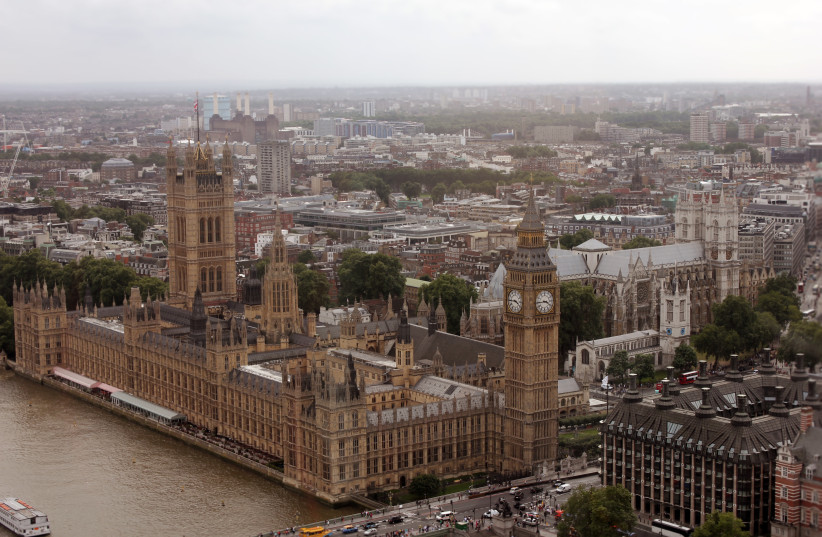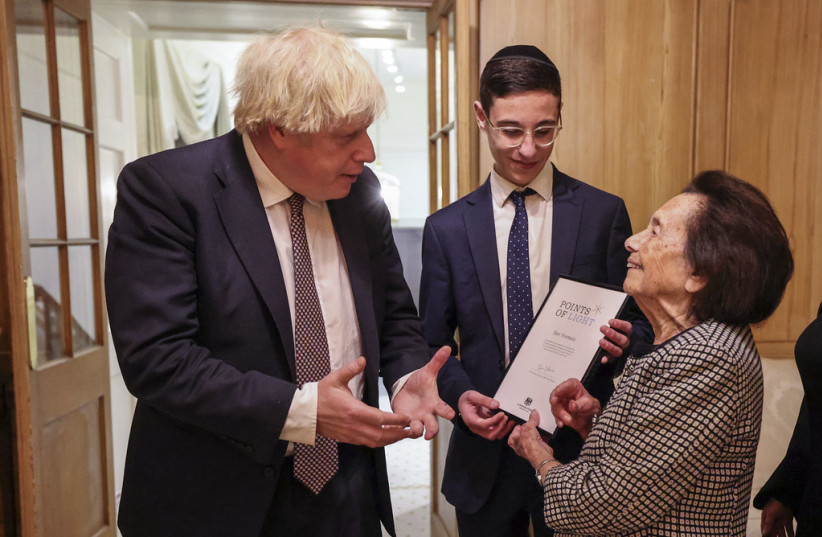The UK Parliament is set to exhibit 30 portraits of people affected by the Holocaust, genocide or identity-based persecution in honor of Holocaust Remembrance Day which is marked internationally at the end of the month of January.
The portraits were chosen in a joint program held by the Holocaust Memorial Day Trust in the UK and The Royal Drawing School that put together the [Extra]Ordinary Portraits exhibition.
"[Extra]Ordinary Portraits is a collection of artworks that reveal the ‘extraordinary elements of seemingly ordinary people’," wrote the Holocaust Memorial Day Trust on its website. "We partnered with The Royal Drawing School and asked young people across the UK to learn about someone affected by the Holocaust, genocide or identity-based persecution and create a portrait of them. An expert judging panel chose 30 to be displayed for Holocaust Memorial Day 2023."
The portraits include a variety of people like Alan Turing who was persecuted for being gay, civil rights activists, and even more recent people like refugees from the Russian-Ukranian war and a woman who was killed in the Iran protests in the last few months.
Which Holocaust survivors are featured?

Kindertransport passengers
Four passengers of the Kindertransport are featured in the portraits: An ink and dipping brush drawing of couple Ann and Bob Kirk by Ellie Jones, a drawing of Bronia Snow by Ali Simmons, and a drawing of Fay Healey by 10-year-old Cerys.
The Kindertransport was a rescue operation authorized by the UK government to rescue children under the age of 17 from the Nazis and transfer them to safety in England. The operation began after Kristallnacht in 1938 and lasted until 1940, saving some 10,000 kids. The first couple of transports left from Germany, but later ones left from other major European cities where the children were in danger from the Nazis.
The children were taken to England without their parents, and most of them never saw their parents again. Once in England, the children were distributed to either group settings or foster families.
Ann and Bob were on separate Kindertransports and only met later in life after the war in 1950. The two married and had two children.
Bronia was on a transport from Prague when she was 11 and was sent to a foster family. She never saw her biological family ever again. She told Simmons that she struggled with faith after the horrors of the Holocaust, but Simmons noted that "Bronia seems resilient, kind and curious."
Fay Healey was on a 1938 transport from Poland at the age of 11. As an adult, Fay was a lollipop lady (a person who helps children cross the road when they are on the way to and from school) at Lander Road Primary School and St. Elizabeth Primary School.
Fay passed away in 2020, and Cerys wrote that she is "remembered fondly among the staff and local residents of Litherland."
Grandad Brennan
Mr. Brennan was painted by his granddaughter Hannah who didn't write his first name.
Hannah wrote that she knew her grandfather was a survivor, but he never spoke about his experiences. After he died last year, she started to find out details of his life in the Holocaust like "the names of camps, his murdered siblings, the forced labor and how he came to England afterwards."
While Hannah found the details jarring and saw a sharp contrast between them and the man she knew, " he was not defined by the terrible experiences he lived through. He was a person who enjoyed reading newspapers, sharing food with family and overzealous pruning of other people's garden shrubs.
"He was a man full of strength, but still just a normal person."
Hannah Brennan
Auguste Spitz
Auguste, unfortunately, did not survive the Holocaust. She was born in Vienna and moved to the British island of Guernsey in her 30s where she registered as a Jew. The island was invaded by the Nazis during the war, and she was deported to France where she was later put on a train to Auschwitz. She did not survive.
Mair Nippers used her registration form as the background to Auguste's portrait and embroidered her registration number over her name.
Gad Beck
Gad was born in Germany to a Jewish-born father and a mother who had converted to Judaism. He managed to avoid "deportation" by the Nazis until 1943 when he was held captive in a building in Rosentstrasse along with the other Jews left in Berlin.
They were released a few days later because of protests by non-Jewish wives and families of the captives. After his release, Gad assumed a leading role in the Chug Chaluzi Jewish resistance group. His activity included arranging safe houses, sending money and helping other Jews escape the Nazis. He believed that a big part of why he was able to be successful was because he was able to turn to his friends in the gay community for help.
Gad was ultimately arrested by the SS in 1945 and held in prison until he and his boyfriend Zwi were liberated by the Red Army in April. A couple of years after the war, Gad moved to Israel (which was still known at Palestine at the time) where he fought in the War of Independence. After living in Israel for a few years, he moved back to Europe where he was an activist for LGBTQ+ rights.
He passed away in 2012 at the age of 88.
Minnie Green created a lino print of Gad and wrote that he "was inspiring to everyone by attempting to save many Jews from the injustice caused by the Nazis."
Frank Bright
Frank's family was living in Prague when the Holocaust began, and they were deported to Theresienstadt Ghetto in 1943. A year later, they were taken to Auschwitz where Frank's mother was murdered in the gas chambers. Frank ultimately survived the concentration camp and moved to England where he had to integrate into life without an education.
Sophia Skrinchuk, who met Frank at her school when he came to speak to them about the Holocaust, drew his portrait to "pay tribute to his experiences and be a lasting memory of the Holocaust."
Lily Ebert
Lily was born in Hungary and was deported to Auschwitz in 1944. Upon arrival, her mother, brother and sister were all sent to the gas chambers, but she and her two sisters were sent to labor. Throughout her time in the concentration camp, Lily held on to a pendant her mother gave her when she was a little girl and kept it with her as a symbol of defiance and a reminder of her mother.

After she was liberated in 1945, Lily moved to Switzerland and then England. She married and had children and grandchildren and wore her pendant every day.
Sadie Ford who created Lily's portrait wrote that she was inspired by "Lily's strength and resilience that she showed during such horrifying conditions and felt impelled to create a portrait in her honor."
Helen Aronson
Helen was born in Poland in 1927. The Nazis arrived two days after the war started in 1939, and five months later, Helen and her family were forced into a ghetto. Two years later, Helen was sent to Lodz. When most of the Jews in Lodz were sent to Auschwitz, Helen, her mother and her brother were left behind, and they stayed there until the Russians showed up and told them that the war was over.
After the Holocaust, Helen went to England where she met her husband and settled down.
Helen was painted by Nancy Akuffobea in acrylics.
Alina Dabrowska
Alina was born in Poland and was arrested during by the Germans for helping Allied forces when she was 20. A year later she was sent to Auschwitz. In 1945, Alina was sent on a death march to Ravensbrück concentration camp, and from there, she was sent to Buchenwald concentration camp. She managed to escape in the last weeks of the war.
Alina stayed in Poland after the war and worked in the country's foreign ministry. She passed away in 2021.
The portrait of Alina was created by Zion Tyson who wrote that "although she is gone now, we can still learn so much about her life."
Primo Levy
Primo Levy is a famous chemist and writer. He graduated from the University of Turin in 1941 and tried to join the resistance against the Nazis two years later. Primo was caught and sent to Auschwitz where he stayed until the end of the Holocaust.

After the war, Primo returned to Turin where he died in 1987. The government ruled his death a suicide.
Kiera Nixon created Primo's portrait.
Rudolph Brazda
Rudolph isn't Jewish, but he was imprisoned in Buchenwald concentration camp alongside so many Jews because he was gay. He survived in part because a Kapo fell in love with him and hid him so that he wouldn't be sent to the death marches shortly before the end of the Holocaust.
Portraits of Rudolph were created by Nahum Hughs and Freya Rowson.
Irene Sendler
Irene Sendler also wasn't Jewish, but as a Polish social worker, she risked her life throughout the Holocaust to save Jews. Her activity got her captured and she was sentenced to death but was saved by her friends who bribed her captors to let her go. Even though she had almost been killed, Irene continued to work underground to continue saving Jews.
Charlotte Walton drew Irene in graphite and crayon and wrote that "she is a huge hero and an inspiration."
To see the portraits visit the Holocaust Memorial Day Trust: https://www.hmd.org.uk/take-part-in-holocaust-memorial-day/young-people/take-part-in-holocaust-memorial-day-young-people-competition/
